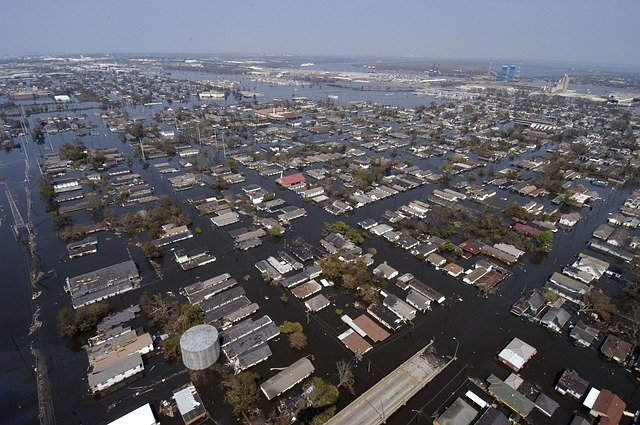Key Findings
- Over 3 million homeowners in the U.S. are about to pay more in flood insurance under the new FEMA flood risk rates
- Premiums will increase for roughly two in three (66%) FEMA’s flood insurance policyholders
- 1 in 10 (11%) of homeowners will see their flood insurance premiums go up by $120, to $240 a year.
- Homeowners in the Southern states like Texas (86%), Mississippi (84%), Florida (80%), Louisiana (80%) are most likely to be affected by the change
- Northeastern states like Connecticut (+$130/year) and Vermont (+$125/year) are projected to see the biggest increase in flood insurance price
- The largest relative increase in flood insurance premiums are expected in Florida (+15%) and Texas (+12%)
Starting October 1st, the Federal Emergency Management Administration (FEMA) l rolled out a new flood risk rating system called “Risk Rating 2.0”, affecting all National Flood Insurance Program (NFIP) policyholders.
Previously, the way FEMA and insurers measured flood risk was based on flood zones. The new risk assessment does not use flood zones, and is instead based on a variety of factors, including distance to flood source, severity and frequency of flooding, and property characteristics, such as the cost to rebuild the property in the event of damage.
All this is supposed to help evaluate flood risk in the most accurate way possible, giving each homeowner a fair price for their flood insurance. But what does this mean in practice?
In practice, this means that 3.3 million households that currently have flood insurance are about to see its price go up. Increases are promised to be minimal and gradual, but with the average price of home insurance through NFIP at $734/year in 2021, how will the new insurance rates affect premiums across the U.S.?
Higher or Lower? How Flood Insurance Prices Are Expected to Change
At the national level, FEMA expects nearly one-quarter (23%) of NFIP policyholders to see a price decrease. Meaning, more than three-quarters (77%) of American homeowners with flood insurance are about to start paying more.
For 66%, the increase would amount to $120 more per year. Meanwhile, for every one in 10 (11%) homeowners, the policy will cost $120 and $240 per year, or even more, at each renewal.
Based on our calculations, a typical price hike in flood insurance premiums would be around $7.35 a month or $88 a year, pushing the annual average price to $822, which is up 12% from what it currently is.

Hawaii and the South: States Where Homeowners Most Likely to Be Affected
Where are homeowners most likely to feel the pinch under the new flood risk assessment policy? Turns out, Hawaii is the state with the highest percentage of households that will be affected (87%), but mostly it’s the Southern states that will be hardest hit.
In Texas, nearly nine in 10 (86%) homeowners are about to see a hike in flood insurance premiums. In the not-so-distant Mississippi, it would affect 84% of homeowners, while in Florida and Louisiana, the price of flood insurance is due to go up for every four in five homeowners (80%).
On the other hand, Alaska, the Washington, D.C. area and multiple states in the Midwest, have the lowest share of homeowners facing flood insurance premium hikes.
In Alaska (14%) and Washington, D.C. (28%), only a minority of households are set to pay more for flood insurance, while in Washington, D.C.-adjacent Maryland, the share is a far greater 39%.
Many Midwestern states are among those with the lowest percentage of homeowners facing flood insurance price hikes. In Michigan, less than half (46%) will be paying more, while in states like Nebraska, Indiana, Ohio, Wisconsin, and Illinois, that share is between 54% and 57% of all homeowners.
Up by $130 in Connecticut, by 15% in Florida: Where Insurance Premiums Are About to Get Expensive
Now that we know where homeowners are most likely to be affected by the flood insurance price premium hikes, let’s see where these hikes are going to be the biggest.
In pure dollar terms, flood insurance in Connecticut is about to get the biggest bump in price to $130/year. Overall, five of the 10 states with the greatest nominal increases in prices are in the Northeastern U.S. Besides Connecticut, also notable is Vermont, where a $125/year bump is expected. Also on the price raise list are Maine ($123), Pennsylvania ($116), and New Hampshire ($113).
However, considering that flood insurance in these states already costs a hefty amount, price hikes might hit harder in states where the increase amounts to a higher percentage of the current flood insurance price.
Thus from a percentage perspective, a whole other set of states emerge as the most affected. In Florida, the flood insurance price is estimated to increase by $90 a year, and while that may not seem like much compared to Connecticut’s $130, it’s 15% more than Floridians are currently paying, meaning Florida has a greater percentage hike.
Joining Florida among the 10 states about to see the biggest relative increase in the price of a flood insurance policy are five other states in the South. In Texas, South Carolina, Alabama, Louisiana, North Carolina, and Mississippi, the prices are projected to rise by between 11% to 12%.
What’s Happening Where You Are? Check Your ZIP Code Below
If you have flood insurance or are looking to get some, you’re probably wondering what this all means for you. It’s worth bearing in mind that everyone’s circumstances are different and your new flood insurance price will—now more than before—depend on the condition of your home and its precise location.
The closest we could get to giving you a sense of how your flood insurance price is about to change is by looking at the policy impact figures published by FEMA, which are sorted by ZIP Code. Try typing in your ZIP Code in the search field below and see what the new flood risk assessment might mean for homes in your area.
What Can You Do? Practical Steps to Lower Your Flood Insurance Premium
Whether your flood insurance premium is going to cost more or less under the new system, bear in mind that the flood risk assessment is no longer based on whether your home is in the flood zone, but includes the factors related to the condition of your home.
This means there are, in fact, things you could do to save on how much you pay for your flood insurance.
According to the recommendations from FloodSmart.gov, improvements that can help you drive the insurance price down are:
- Installing flood openings on exterior walls
- Backfilling the basement to help withstand potential flooding
- Elevating the heating and cooling systems, water heaters, electrical panels, and other utilities
- Elevating the property altogether
Other ways to save on your premium are to consider a higher deductible in favor of a lower monthly payment, to purchase an elevation certificate, and to check whether your local government participates in FEMA’s Community Rating System (CRS).
Communities that are part of the CRS can receive grants from the federal government to lower the flood risk for local areas at scale, rather than having to rely on individual homeowners to invest in flood risk mitigation projects. You can check whether your town, city or local community participates in the CRS on this page.
–
Sources and Methodology
Data used in the charts was taken from FEMA official website.
Premium increases were calculated only for the households with National Flood Insurance Program (NFIP) policies, which were projected to see an increase in their premium, according to FEMA’s new risk assessment system.The average increase was calculated as the mean of grouped data, using the number of households in each price increase band, as detailed in FEMA’s projections.
–
Header Image by Pete Linforth from Pixabay
Second Image by David Mark from Pixabay



